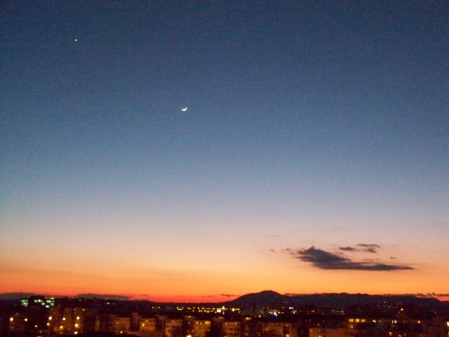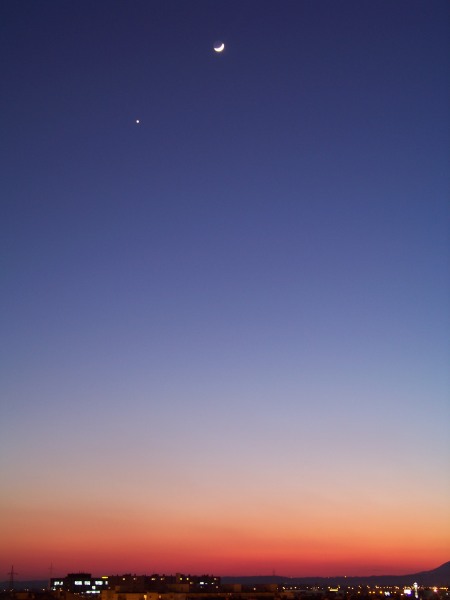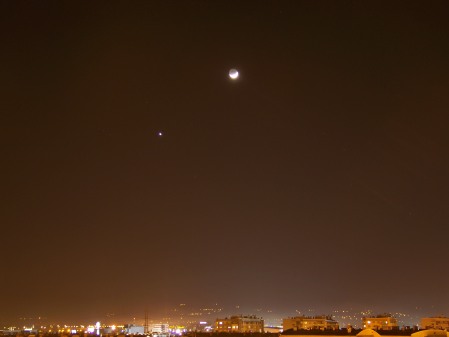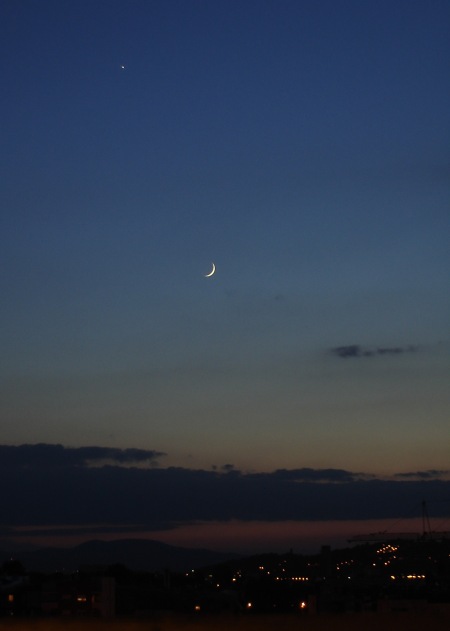 It is well-know that the Aristotelian conception of the universe, adopted with some adaptations in the Middle Ages, divided the universe in two essentially different parts: the sublunar world of the four elements with their natural places – thus forming the layers of earth, water, air and fire – and the supralunar world of the fifth element, aither. The four elements have different natural motions (earth and water naturally go down, fire and air up), and objects made of them in various mixtures undergo all forms of change, including generation and destruction. The fifth element’s natural motion is circular, and objects made of it – the celestial spheres and stars attached to them – undergo only one sort of change, and that is change of place, or more precisely circular locomotion. Because they are made of the fifth element, the heavens and the stars are completely unchangeable.
It is well-know that the Aristotelian conception of the universe, adopted with some adaptations in the Middle Ages, divided the universe in two essentially different parts: the sublunar world of the four elements with their natural places – thus forming the layers of earth, water, air and fire – and the supralunar world of the fifth element, aither. The four elements have different natural motions (earth and water naturally go down, fire and air up), and objects made of them in various mixtures undergo all forms of change, including generation and destruction. The fifth element’s natural motion is circular, and objects made of it – the celestial spheres and stars attached to them – undergo only one sort of change, and that is change of place, or more precisely circular locomotion. Because they are made of the fifth element, the heavens and the stars are completely unchangeable.
In De caelo I.3, 270b12-16, Aristotle wrote: “Throughout all past time, according to the records handed down from generation to generation, nothing is observed to have changed either in the whole of the outermost heaven <viz. the sphere of the fixed stars> or in any of its proper parts.”
Simplicius (6th century AD) comments on this sentence that, according to his knowledge, astronomical records of the Egyptians go back 630.000 years, of and the Babylonians 1.440.000 years. This is surely a gross overstatement, but their records were certainly older than the Greeks’ for several hundred years. “In all that time since the records have been passed on,” writes Simplicius, “there is no mention of anything being different in the heavens than today, either concerning (i) the number of stars, or (ii) their sizes, or (iii) their colours, or (iv) their regular motions” (117.27-30 Heiberg)
Ad (i): The exact number of stars has been proverbial in antiquity as beyond human cognition. In fact, however, there are only some six thousand stars visible to the naked eye in a typical dark night.
One way for the number of stars to change, of course, would be if a new star appears in the sky. It is well-know that Tycho Brahe observed a new star in November 1572 (SN 1572) and he described it in his 1573 treatise De stella nova. He argued that it showed no daily parallax against the background of the fixed stars, which means that it cannot be a sublunar phenomenon. Tycho concluded that the traditional view of the heavens as unchangeable cannot be correct. This observation was instrumental in overthrowing the traditional view in early modern age.
Before Tycho, we have records of two more new star observations in the West, both made by Islamic astronomers: in 1054 (SN 1054) and in 1006 (SN 1006). Weren’t there any observable supernovas in antiquity? The earliest positively recorded supernova was in 185 AD (SN 185), viewed by Chinese astronomers in the southern sky. Other than that, we have a report that Hipparchus, the greatest observational astronomer of antiquity, saw a “new star” in 134 BC. Pliny wrote in his monumental work Natural History, Book II.95: “Hipparchus before-mentioned, who can never be sufficiently praised, no one having done more to prove that man is related to the stars and that our souls are a part of heaven, detected a new star that came into existence during his lifetime; the movement of this star in its line of radiance led him to wonder whether this was a frequent occurrence, whether the stars that we think to be fixed are also in motion; and consequently he did a bold thing, that would be reprehensible even for God – he dared to schedule the stars for posterity, and tick off the heavenly bodies by name in a list, devising machinery by means of which to indicate their several positions and magnitudes, in order that from that time onward it might be possible easily to discern not only whether stars perish and are born, but whether some are in transit and in motion, and also whether they increase and decrease in magnitude.” However, the stella nova observed by Hipparchus seems to have been a comet, given that Hipparchus mentions its proper motion, and comets were deemed to be sublunar phenomena in Aristotle’s theory (cf. J. K. Fotheringham). This explains Simplicius’ confident claim that there has been no record of change in the number of stars. In any case, much like Charles Messier eighteen hundred years later, with his catalogue of nebulae not to be confused with comets, Hipparchus made a star atlas so that any new stars or proper motions of stars can be more easily detected.
Ad (ii): The size (megethos) of stars must refer to their brightness. And what is truly striking is that ancient and medieval astronomers failed to observe variable stars, that is stars of changing brightness. There are tens of stars in the northern sky whose variations are easily detectable with the naked eye. Of course, one needs to know where to look, but more importantly – one needs to be open to the idea that variations are possible, and that seems to be something that ancient and medieval astronomers lacked. Even if they did observe a variation in brightness, they would probably dismiss it as a result of atmoshperic changes. This is a nice example of theory not only guiding observation, but also obstructing it.
Ad (iii): The ancients were well aware of different colours of stars and planets, but there is no record – to my knowledge – that they ever observed variation in their colour. However, it would be extremely difficult to observe such a variation without a spectrograph.
Ad (iv): Famously, Hipparchus discovered the precession of the equinoxes, the slow movement of the equinoctial points from east to west among the stars along the ecliptic, which we know today is due to the wobble of the Earth’s axis. Would that not be a counterexample to Simplicius’ claim that there has been no record of any change in the regular motion of stars? Perhaps not, if the precession of the equinoxes can be explained as another regular motion. However, this could only be a regular motion of the sphere of the fixed stars, and I am not aware that anyone in antiquity entertained the idea that the sphere of the fixed stars undergoes any other than the diurnal motion.
Perhaps someone can help me with this. (1) How did ancient astronomers and philosophers explain the precession of the equinoxes? (2) How come that Simplicius could affirm point (iv) in the light of Hipparchus’ discovery of the precession? Needless to say, other comments are most welcome.








 Posted by Pavel Gregoric
Posted by Pavel Gregoric 






